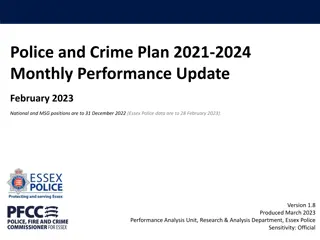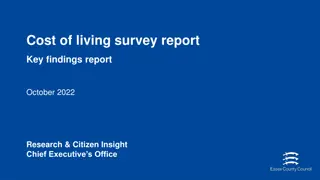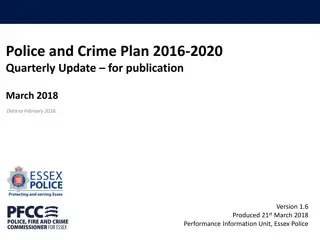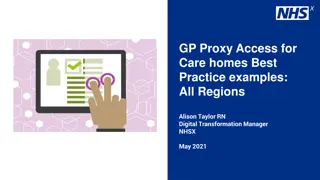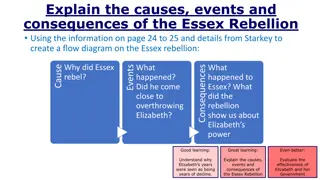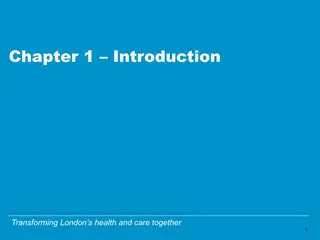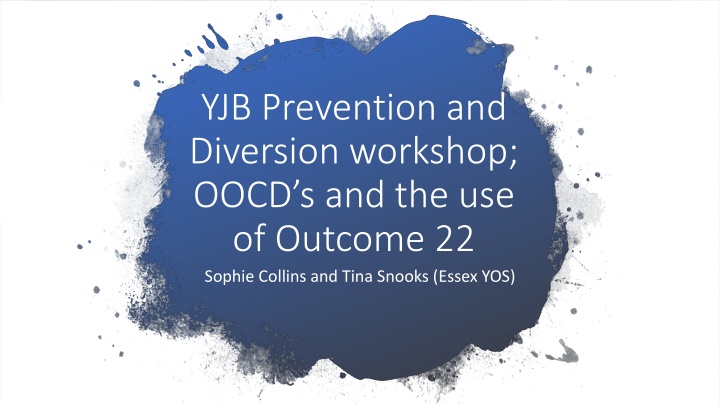
Outcome 22 in Youth Justice: Essex YOS Approach
Explore the implementation of Outcome 22 in youth justice by Essex Youth Offending Service (YOS). Discover how diversionary actions are taken to address offending behavior and prevent reoffending, with a focus on the criteria for applying Outcome 22 and the collaborative efforts between YOS and the police. The Essex ethos emphasizes swift identification and diversion to support young individuals involved in the criminal justice system.
Download Presentation

Please find below an Image/Link to download the presentation.
The content on the website is provided AS IS for your information and personal use only. It may not be sold, licensed, or shared on other websites without obtaining consent from the author. If you encounter any issues during the download, it is possible that the publisher has removed the file from their server.
You are allowed to download the files provided on this website for personal or commercial use, subject to the condition that they are used lawfully. All files are the property of their respective owners.
The content on the website is provided AS IS for your information and personal use only. It may not be sold, licensed, or shared on other websites without obtaining consent from the author.
E N D
Presentation Transcript
YJB Prevention and Diversion workshop; OOCD s and the use of Outcome 22 Sophie Collins and Tina Snooks (Essex YOS)
Diversionary, educational or intervention activity, resulting from the crime report, has been undertaken and it is not in the public interest to take any further action Use where no further action (NFA) is taken but diversionary action has been undertaken to address offending behaviour to prevent further offending / change behaviours of offender. Outcome 22: the Outcome 22: the national context national context (Police outcomes (Police outcomes checklist) checklist) The activity has to have been completed before the outcome can be applied for. Can be used at any stage of the investigation
After a YP has had an Outcome 22 applied to a crime they have committed, if they commit a further crime consideration to applying Outcome 22 again for a further crime can only be considered on a case by case basis depending on the exact circumstances. Outcome 22 Outcome 22 (Police (Police Outcomes Outcomes Checklist) Checklist) The following points MUST be considered and the rationale for decision recorded: The crime types committed The impact on the victim(s) How much time has there been between each offence If the diversionary, educational or intervention activity has not worked the first time why is it appropriate to do this again?
YOS manage CR to YCC Essex is a large geographical area: county wide OOCD panel (multi agency, RJ/YOS /Police/POWER/Youth service & The Children s Society) Centralised OOCD team with OOCD leads in each locality team. No YOS PC, instead Essex Police support staff (not warranted Officers), who filter referrals into the YOS. 2020 Essex YOS OOCD review to shape processes/delivery of OOCD s. The review found that outcome 22 accounted for nearly 25 % of OOCD panel outcomes The Essex The Essex Context Context
The Essex Ethos is to respond swiftly to identify and divert at the earliest opportunity Police/YOS referral consultation meeting: - In response to over representation of outcome 22 in panel - YOS /police working together to identify those cases that should be diverted (YP History, drivers, existing support) - Only those that need to be part of the criminal justice system should be discussed at panel (repeated stories , assessments, resources, YOS database) - Guards against the risks asc with net widening in youth diversion schemes (Centre for Justice Innovation) - Training with partners/CSC re YP that need YOS - proportionality Ethos Ethos
OIC referral to the Essex Police Youth Justice Team (Police support staff) who screen for suitability (admissions/evidential threshold etc). YOS/Police referral consultation meeting (YP diverted at this stage where appropriate not recorded on YOS database) YP allocated for pre panel OOCD assessment by YOS, and booked into panel. Discussed in the multi agency OOCD Panel. Decision and rationale recorded. Where YOS intervention, planning meeting with YP/parent/carer, YOS and Police within 10 working days. Essex YOS Essex YOS OOCD Process OOCD Process
leave https://assets.publishing.service.gov.uk/government/uploads/system/uploads/attachment_da ta/file/765082/The_national_protocol_on_reducing_unnecessary_criminalisation_of_looked- after_children_and_care_.pdf The National protocol on reducing unnecessary criminalisation for Looked after children and care leavers. Coming into contact with the criminal justice system tends to increase the likelihood of offending, and children and young people, especially the most vulnerable, such as looked after children, should be diverted from it wherever possible . we must recognise that the vast majority of looked-after children enter care due to abuse and neglect, and the impact of trauma and abuse, or additional vulnerabilities, on emotional development. This can perceived as challenging responses to such behaviours. We must meet the challenge of balancing the rights and needs of highly vulnerable children and young people and those of their carers and/or the public in deciding how to respond to incidents, and whether a formal criminal justice response is appropriate. and behavioural behaviour should result and in inform
A is a Looked after child. He has been referred by Police for consideration of an OOCD for criminal damage. He had an argument with another YP in placement and went to his bedroom, causing damage to his wardrobe door, and chest of drawers. The placement practices RJ and has spoken to him about it after the event, and he has helped staff to repair some of the damage. He expressed remorse and agreed to pay back 10 from his personal allowance. Case study A Case study A
B is subject to a CIN plan. Dbit are also supporting the family. B s behaviour in recent months has become increasingly unsettled. Just before bedtime, B said she was going to go out. Her parents refused so she caused damage to an internal door by punching it, and hitting her Dad on the arm causing no injury. Case study B Case study B Police refer B to the OOCD panel for Criminal Damage and Common assault.
C is referred into the OOCD panel for causing Criminal Damage within school. He slammed a door causing minor dent in wall where the handle made contact with it. The PENY describes how the YP has subsequently apologised face to face with the teacher that he was angry with, has written to the Headteacher to apologise for the damage, and has begun to engage with the school counsellor. Case study C Case study C











